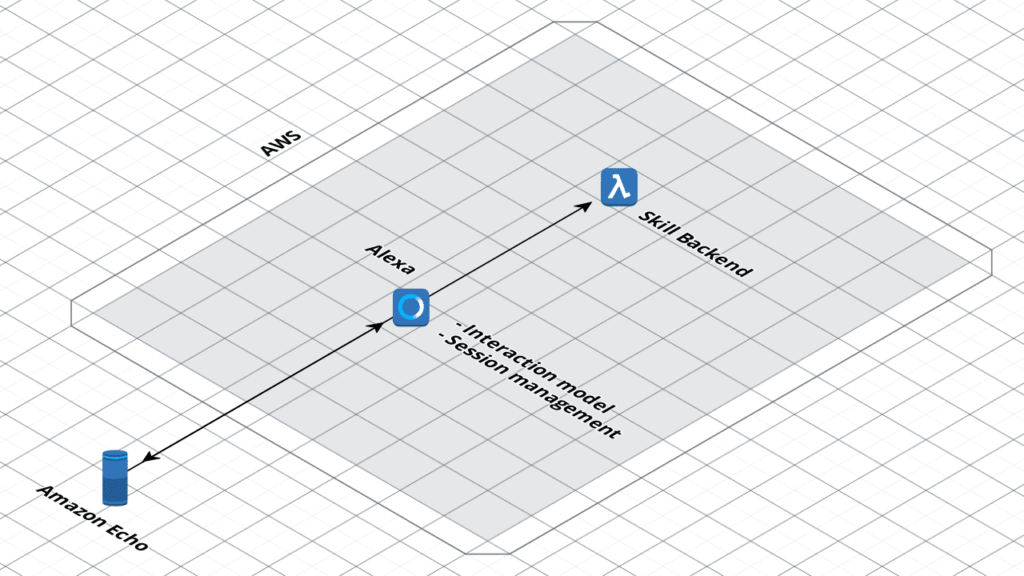VPC Lattice: yet another connectivity option or a game-changer?
12 April 2024 - 4 min. read
Damiano Giorgi
DevOps Engineer

How many of you have an Alexa-enabled device or a voice assistant?These devices create a way of interacting with services and applications that are completely different from what we are used to.Through Alexa, Amazon has become one of the main players in a real revolution of user experience.In this article, we will explain in detail how an Alexa Skills works. We will also provide you with an interaction model plus the code snippet for creating a minimal back-end.Definitions are important. Before going further, we will introduce the terms and concepts that we are going to use throughout the following paragraphs of this article.
 Here is how a high-level skill interaction works:When the user speaks to an Echo device, it records the audio and sends it to Alexa via AVS. At this point, Alexa will be able to identify and address the skill in one of the following ways:
Here is how a high-level skill interaction works:When the user speaks to an Echo device, it records the audio and sends it to Alexa via AVS. At this point, Alexa will be able to identify and address the skill in one of the following ways:{
"interactionModel": {
"languageModel": {
"invocationName": "saluti",
"intents": [
{
"name": "AMAZON.CancelIntent",
"samples": [
"no",
"niente",
"non fa niente",
"lascia perdere",
"annulla"
]
},
{
"name": "AMAZON.HelpIntent",
"samples": []
},
{
"name": "AMAZON.StopIntent",
"samples": [
"abbandona",
"esci",
"fine",
"stop"
]
},
{
"name": "Salutare",
"slots": [],
"samples": [
"salutarmi",
"salutami",
"saluti",
"ciao"
]
}
],
"types": []
}
}
}
This model defines a single intent with the "Greeting" identification, plus the standard Amazon intent of "cancel", "stop", and "help". No parameters are required. Rather, a few sample phrases are provided.It is a working model in its simplicity. Additionally, it fulfills the purpose of being greeted by Alexa.The back-end, meaning the service that is able to respond to the requests that Alexa performs once the intent has been identified is, however, missing.Here is a snippet to correctly answer calls related to the intent defined above, assuming the use of AWS Lambda.It involves a Nodejs function, whose code uses the Alexa SDK for each node. In red, we have highlighted in red the function that is invoked for the "Greeting" intent.The rest of the code is essentially a boilerplate. It remains almost completely unaltered, even for more complex skills.let speechOutput;
let reprompt;
let welcomeOutput = "Benvenuto in 'Ciao' in italiano. Puoi salutarmi per essere salutato a tua volta";
let welcomeReprompt = "puoi solo dire 'ciao' per essere salutato";
"use strict";
const Alexa = require('alexa-sdk');
const APP_ID = undefined;
speechOutput = '';
const handlers = {
'LaunchRequest': function() {
this.emit(':ask', welcomeOutput, welcomeReprompt);
},
'AMAZON.HelpIntent': function() {
speechOutput = 'Placeholder response for AMAZON.HelpIntent.';
reprompt = '';
this.emit(':ask', speechOutput, reprompt);
},
'AMAZON.CancelIntent': function() {
speechOutput = 'Ok, annullato’;
this.emit(':tell', speechOutput);
},
'AMAZON.StopIntent': function() {
speechOutput = 'Arrivederci';
this.emit(':tell', speechOutput);
},
'SessionEndedRequest': function() {
speechOutput = '';
this.emit(':tell', speechOutput);
},
'Salutare': function() {
speechOutput = '';
speechOutput = "Ciao! Questo è tutto quello che puoi fare per ora”;
this.emit(":tell", speechOutput, speechOutput);
},
'Unhandled': function() {
speechOutput = "Non ho capito. Riprova";
this.emit(':ask', speechOutput, speechOutput);
}
};
exports.handler = (event, context) => {
const alexa = Alexa.handler(event, context);
alexa.appId = APP_ID;
// To enable string internationalization (i18n) features, set a resources object.
//alexa.resources = languageStrings;
alexa.registerHandlers(handlers);
//alexa.dynamoDBTableName = 'DYNAMODB_TABLE_NAME'; //uncomment this line to save attributes to DB
alexa.execute();
};
// END of Intent Handlers {} ========================================================================================
// 3. Helper Function =================================================================================================
function resolveCanonical(slot) {
//this function looks at the entity resolution part of request and returns the slot value if a synonyms is provided
let canonical;
try {
canonical = slot.resolutions.resolutionsPerAuthority[0].values[0].value.name;
}
catch (err) {
console.log(err.message);
canonical = slot.value;
};
return canonical;
};
function delegateSlotCollection() {
console.log("in delegateSlotCollection");
console.log("current dialogState: " + this.event.request.dialogState);
if (this.event.request.dialogState === "STARTED") {
console.log("in Beginning");
let updatedIntent = null;
// updatedIntent=this.event.request.intent;
//optionally pre-fill slots: update the intent object with slot values for which
//you have defaults, then return Dialog.Delegate with this updated intent
// in the updatedIntent property
//this.emit(":delegate", updatedIntent); //uncomment this is using ASK SDK 1.0.9 or newer
//this code is necessary if using ASK SDK versions prior to 1.0.9
if (this.isOverridden()) {
return;
}
this.handler.response = buildSpeechletResponse({
sessionAttributes: this.attributes,
directives: getDialogDirectives('Dialog.Delegate', updatedIntent, null),
shouldEndSession: false
});
this.emit(':responseReady', updatedIntent);
}
else if (this.event.request.dialogState !== "COMPLETED") {
console.log("in not completed");
// return a Dialog.Delegate directive with no updatedIntent property.
//this.emit(":delegate"); //uncomment this is using ASK SDK 1.0.9 or newer
//this code necessary is using ASK SDK versions prior to 1.0.9
if (this.isOverridden()) {
return;
}
this.handler.response = buildSpeechletResponse({
sessionAttributes: this.attributes,
directives: getDialogDirectives('Dialog.Delegate', null, null),
shouldEndSession: false
});
this.emit(':responseReady');
}
else {
console.log("in completed");
console.log("returning: " + JSON.stringify(this.event.request.intent));
// Dialog is now complete and all required slots should be filled,
// so call your normal intent handler.
return this.event.request.intent;
}
}
function randomPhrase(array) {
// the argument is an array [] of words or phrases
let i = 0;
i = Math.floor(Math.random() * array.length);
return (array[i]);
}
function isSlotValid(request, slotName) {
let slot = request.intent.slots[slotName];
//console.log("request = "+JSON.stringify(request)); //uncomment if you want to see the request
let slotValue;
//if we have a slot, get the text and store it into speechOutput
if (slot && slot.value) {
//we have a value in the slot
slotValue = slot.value.toLowerCase();
return slotValue;
}
else {
//we didn't get a value in the slot.
return false;
}
}
//These functions are here to allow dialog directives to work with SDK versions prior to 1.0.9
//will be removed once Lambda templates are updated with the latest SDK
function createSpeechObject(optionsParam) {
if (optionsParam && optionsParam.type === 'SSML') {
return {
type: optionsParam.type,
ssml: optionsParam['speech']
};
}
else {
return {
type: optionsParam.type || 'PlainText',
text: optionsParam['speech'] || optionsParam
};
}
}
function buildSpeechletResponse(options) {
let alexaResponse = {
shouldEndSession: options.shouldEndSession
};
if (options.output) {
alexaResponse.outputSpeech = createSpeechObject(options.output);
}
if (options.reprompt) {
alexaResponse.reprompt = {
outputSpeech: createSpeechObject(options.reprompt)
};
}
if (options.directives) {
alexaResponse.directives = options.directives;
}
if (options.cardTitle && options.cardContent) {
alexaResponse.card = {
type: 'Simple',
title: options.cardTitle,
content: options.cardContent
};
if (options.cardImage && (options.cardImage.smallImageUrl || options.cardImage.largeImageUrl)) {
alexaResponse.card.type = 'Standard';
alexaResponse.card['image'] = {};
delete alexaResponse.card.content;
alexaResponse.card.text = options.cardContent;
if (options.cardImage.smallImageUrl) {
alexaResponse.card.image['smallImageUrl'] = options.cardImage.smallImageUrl;
}
if (options.cardImage.largeImageUrl) {
alexaResponse.card.image['largeImageUrl'] = options.cardImage.largeImageUrl;
}
}
}
else if (options.cardType === 'LinkAccount') {
alexaResponse.card = {
type: 'LinkAccount'
};
}
else if (options.cardType === 'AskForPermissionsConsent') {
alexaResponse.card = {
type: 'AskForPermissionsConsent',
permissions: options.permissions
};
}
let returnResult = {
version: '1.0',
response: alexaResponse
};
if (options.sessionAttributes) {
returnResult.sessionAttributes = options.sessionAttributes;
}
return returnResult;
}
function getDialogDirectives(dialogType, updatedIntent, slotName) {
let directive = {
type: dialogType
};
if (dialogType === 'Dialog.ElicitSlot') {
directive.slotToElicit = slotName;
}
else if (dialogType === 'Dialog.ConfirmSlot') {
directive.slotToConfirm = slotName;
}
if (updatedIntent) {
directive.updatedIntent = updatedIntent;
}
return [directive];
}Here, we have covered the fundamental concepts underlying the Alexa functioning. We then analyzed the anatomy of a simple and functional skill, which is the first step in realizing more complex and potentially publishable skills.However, for publication, there are compliance limitations and rules to be considered when designing a voice interface.We will address this and many other important aspects of the publication and implementation phase throughout the following articles. But first, we will publish a detailed tutorial for the creation of a non-"trivial" skill.We will not give you any hints :-)Stay tuned!Would you like to learn more about AWS Lambda or Serverless development?Then read our series of articles on these topics!